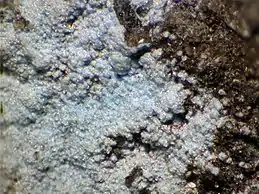Spertiniite
Spertiniite is a rare copper hydroxide mineral. Chemically it is copper(II) hydroxide with formula Cu(OH)2. It occurs as blue to blue green tabular orthorhombic crystal aggregates in a secondary alkaline environment altering chalcosite. Associated minerals include chalcocite, atacamite, native copper, diopside, grossular and vesuvianite.[2]
| Spertiniite | |
|---|---|
 Spertiniite from Dzhezkazgan, Kazakhstan (size: 5 mm) | |
| General | |
| Category | Oxide mineral |
| Formula (repeating unit) | Cu(OH)2 |
| Strunz classification | 4.FD.05 |
| Dana classification | 6.2.4.1 |
| Crystal system | Orthorhombic |
| Crystal class | Pyramidal (mm2) H-M symbol: (mm2) |
| Space group | Cmc21 |
| Unit cell | a = 2.95 Å, b = 10.59 Å c = 5.27 Å; Z = 4 |
| Identification | |
| Formula mass | 97.56 g/mol |
| Color | Blue, blue-green |
| Crystal habit | Flat tabular crystals occurring in radial to botryoidal aggregates |
| Cleavage | None |
| Tenacity | Brittle |
| Mohs scale hardness | Soft |
| Luster | Vitreous |
| Diaphaneity | Transparent |
| Specific gravity | 3.93 |
| Optical properties | Biaxial |
| Refractive index | nα = 1.720, nβ= n.d., nγ = > 1.800 |
| Pleochroism | Strong; X = colorless; Z = dark blue |
| Other characteristics | Decomposes in hot water (synthetic) |
| References | [1][2][3] |
Discovery and occurrence
It was first described in 1981 for an occurrence in the Jeffrey quarry of the Johns-Manville mine, Asbestos, Estrie, Québec. It was named for mine geologist Francesco Spertini (born 1937).[1][2] In addition to the type locality, it has also been reported from Mont Saint-Hilaire, Quebec; Ely, White Pine County, Nevada; and Bisbee, Cochise County, Arizona. It has been reported from Dzhezkazgan, Kazakhstan; from slag at Juliushutte, Astfeld, Harz Mountains, Germany; and from Tsumeb, Namibia.[2]
A 2006 study has produced evidence the blue mineral chrysocolla may be a microscopic mixture of spertiniite, amorphous silica and water.[4][5]
-hydroxid.png.webp)
References
- Spertiniite on Mindat
- Spertiniite in the Handbook of Mineralogy
- Spertiniite on Webmineral
- François Farges, Karim Benzerara, Gordon E. Brown, Jr.; Chrysocolla Redefined as Spertiniite; SLAC-PUB-12232; 13th International Conference On X-Ray Absorption Fine Structure (XAFS13); July 9-14, 2006; Stanford, California
- Chrysocolla on Mindat